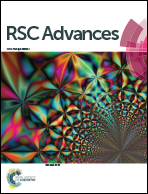Separation of CH4/N2 mixtures in metal–organic frameworks with 1D micro-channels†
Abstract
This work aims to study the features of CH4 and N2 adsorption inside 1D micro-channels and develop the best suitable MOF candidates for the adsorptive separation of CH4 against N2. For this purpose, four MOFs ([Ni3(HCOO)6], [Cu(INA)2], Al-BDC and Ni-MOF-74) with similar network topology and single 1D micro-channel have been systematically investigated via structure characterization and selective gas adsorption and separation. The selected MOFs are classified into three groups. Thereinto, Ni-MOF-74, with coordinatively unsaturated metal sites, is considered as strong polar adsorbent, whilst Al-BDC is treated as moderate polar adsorbent owing to the polar linkers. However, [Ni3(HCOO)6] and [Cu(INA)2] are regarded as apolar (weak polarity) adsorbents because of lack of any polar functional groups inside the frameworks. The adsorption potential of CH4 follows the trend Ni-MOF-74 > [Ni3(HCOO)6] > [Cu(INA)2] > Al-BDC, while Ni-MOF-74 > Al-BDC > [Ni3(HCOO)6] > [Cu(INA)2] for the potential of N2. This implies that pore size and electrostatic interactions have different contributions to the CH4 or N2–MOFs interactions, resulting in excellent CH4/N2 selectivity more than 6 on [Ni3(HCOO)6] and [Cu(INA)2].



 Please wait while we load your content...
Please wait while we load your content...